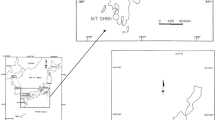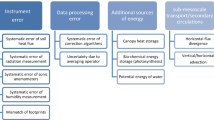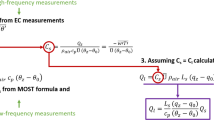Abstract—
Strong seasonal variations in the radon exhalation rate from the soil surface were revealed during a two-year monitoring cycle in a fault zone on a slope of Mount Beshtau in the Caucasus Mineral Water Resort area, Russia. The variations are characterized by very high radon levels in summer and low levels in winter. In the warm season (from late April to early October), the radon exhalation rate values ranged from 4.5 to 23.8 Bq m–2 s–1. During the cold period (from November to March), the radon levels decreased to 0.04–0.17 Bq m–2 s–1. A strong correlation was found between the radon exhalation and atmospheric air temperature (the Pearson correlation coefficient is 0.8). The simulation results show that seasonal fluctuations in the radon exhalation rate are caused by an inversion of the convective radon transport direction in the fractured zones of the rock massif. In summer, the convective flow of radon is directed from the rock massif to atmosphere, whereas this flow in winter comes from the atmosphere to rock massif. The rate of convective transport varies from 5 to 28 m day–1 during the warm season and from –2 to –4 m day–1 during the cold one. Seasonal radon anomalies in fault zones are most probably caused by thermally induced convective air flows in the highly permeable rock zone due to the temperature difference between the rock air and atmospheric air. Seasonal radon anomalies should be taken into account both when mapping radon risk and when using radon as a tracer of gas transport in geochemical and geophysical research.






Similar content being viewed by others
REFERENCES
A. Annunziatellis, S. E. Beaubien, S. Bigi, G. Ciotoli, M. Coltella, and S. Lombardi, “Gas migration along fault systems and through the vadose zone in the Latera caldera (central Italy): implications for CO2 geological storage,” Int. J. Greenh. Gas Con. 2 (3), 353–372 (2008).
H. Arvela, A. Voutilainen, T. Honkamma, and A. Rosenberg, “High indoor radon variations and the thermal behaviour of eskers,” Health Phys. 67, 254–260 (1994).
L. C. Baubron, A. Rigo, and J. P. Toutain, “Soil gas profiles as a tool to characterise active tectonic areas: the Jaut Pass example (Pyrenees, France),” Earth Planet. Sci. Lett. 196, 69–81 (2002).
G. Ciotoli, S. Bigi, and G. P. Cavinato, “Radon distribution as shallow evidence of buried fault geometry in the Fucino plain (Central Italy),” 6th International INQUA Meeting on Paleoseismology, Active Tectonics and Archaeoseismology, Pescina, Fucino Basin, Italy, 2015 (Pescina, 2015), Vol.6, pp. 79–82.
A. P. Degtyarev, “Temperature-dynamic types of cave entrances,” Vopr. Geografii 147, 299–310 (2018).
J.-P. Drolet, and R. Martel, “Distance to fault as a proxy for radon gas concentration in dwellings,” J. Environ. Radioactiv. 152, 8–15 (2016).
P. P. Firstov, E. A. Ponomarev, N. V. Cherneva, A. V. Buzevich, and O. P. Malysheva, “On the effects of air pressure variations on radon exhalation into the atmosphere,” J. Volcanol. Seismol. 1(6), 397–404 (2007).
Ll. Font, C. Baixeras, V. Moreno, and J. Bach, “Soil radon levels across the Amer fault,” Radiat. Meas. 43, 319–323 (2008).
V. M. Golod, and M. P. Golod, “Microclimate of gypsum cave of the Pinega region,” Caves of the Pinega–Severnaya Dvina Karst Area (Nauka, Leningrad, 1974), pp. 128–155 [in Russian].
P. Hernández, N. Pérez, J. Salazar, M. Reimer, K. Notsu, and H. Wakita, “Radon and helium in soil gases at Cañaadas caldera, Tenerife, Canary Islands, Spain,” J. Volcanol. Geotherm. Res. 131, 59–76 (2004).
S. Inan, A. Kop, H. Cetin, F. Kulak, Z. Pabuccu, C. Seyis, S. Ergintav, O. Tan, R. Saatcilar, and M. Nuri Bodur, “Seasonal variations in soil radon emanation: long–term continuous monitoring in light of seismicity,” Nat. Hazards 62, 575–591 (2012).
K. Jüriado, V. Petersell, and A. Raukas, “Seasonal variations of radon concentration in soil air in different geological conditions on the example of Estonia,” Geologija 56 (4), 97–107 (2014).
E. I. Karpenko, N. I. Sanzharova, S. I. Spiridonov, and I. S. Serebryakov, “Radioecological setting in the locality of the former LPO Almaz uranium-mining enterprise,” Radiatsiya Risk, No. 4, 73–81 (2009).
C. Y. King, “Radon emanation on San Andreas fault,” Nature 271, 516–519 (1978).
C. Y. King, B. S. King, and W. C. Evans, “Spatial radon anomalies on active faults in California,” Appl. Geochem. 11, 497–510 (1996).
V. L. Lezhnin, M. V. Zhukovsky, E. V. Polzik, V. S. Kazantsev, and O. A. Pakholkina, “A Multifactorial assessment of carcinogenic risks of radon for the population residing in a Russian radon hazard zone,” Arch. Oncol. 19 (1–2), 3–8 (2011).
V. S. Lukin “Temperature anomalies in the Cis-Uralian caves and critical analysis of theories ofunderground cold,” Peshchery 5 (6), 164–172 (1965).
Main Sanitary Rules for Maintaining the Radiation Safety (OSPORB 99/2010) SP 2.6.1.2612–10 (Rospotrebnadzor, Moscow, 2010).
A. M. Marennyi, A. A. Tsapalov, P. S. Miklyaev, and T. B. Petrova, Regularities in the Formation of Radon field in the Geological Medium (Pero, Moscow, 2016) [in Russian].
G. A. Mashkovtsev, A. K. Konstantinov, A. K. Miguta, M. V. Shumilin, and V. N. Shchetochkin, Uranium of the Russian Interiors (VIMS, Moscow, 2010) [in Russian].
P. S. Miklyaev, A. A. Tsapalov, A. M. Marenneyi, M. N. Lopatin, V. T. Farafutdinov, and T. B. Petrova, “Multidisciplinary monitoring studies of radon fields of ground massifs. Part 7. Results of monitoring of the radon field in the active tectonic fault zone in the Baikal rift zone,” ANRI (3), 19–34 (2016).
P. S. Miklyaev, T. B. Petrova, A. M. Marenneyi, N.A. Nefedov, T. V. Ostapchuk, D. V. Shchitov, P. A. Sidyakin, and M. A. Murzabekov, “Levels of radon exhalation on the western slope of Mt. Beshtau, Caucasian Mineral Waters,” Geoekologiya, No. 5, 20–30 (2018).
V. Moreno, J. Bach, C. Baixeras, and Ll. Font, “Characterization of blowholes as radon and thoron sources in the volcanic region of La Garrotxa,” Spain. Radiat. Meas. 44, 929–933 (2009).
V. Moreno, J. Bach, Ll. Font, C. Baixeras, M. Zarroca, R. Linares, and C. Roqué, “Soil radon dynamics in the Amer fault zone: An example of very high seasonal variations,” J. Environ. Radioactiv. 151, 293–303 (2016).
V. Moreno, J. Bach, M. Zarroca, Ll. Font, C. Roqué, and R. Linares, “Characterization of radon levels in soil and groundwater in the North Maladeta Fault area (Central Pyrenees) and their effects on indoor radon concentration in a thermal spa,” J. Environ. Radioactiv. 189, 1–13 (2018).
M. Neri, E. Ferrera, S. Giammanco, G. Currenti, R. Cirrincione, G. Patan, and V. Zanon, “Soil radon measurements as a potential tracer of tectonic and volcanic activity,” Sci. Rep. 6, 24581 (2016)
V. A. Nivin, V. V. Pukha, A. V. Lovchikov and R. G. Rakhimov, “Features and Factors of Time Variations in Hydrogen Release at Lovozersky Rare-Metal Deposit (Kola Peninsula),” Geochem. Int. 56 (7), 688–701 (2018).
C. Papastefanou, “Variation of radon flux along active fault zones in association with earthquake occurrence,” Radiat. Meas. 45, 943–951 (2010).
F. Perrier, P. Richon, and J–C. Sabroux, “Temporal variations of radon concentration in the saturated soil of Alpine grassland: The role of groundwater flow,” Sci. Total Environ. 407, 2361–2371 (2009).
V. P. Rudakov, Emanation Monitoring of Geoenvironments and Processes (Nauchnyi Mir, Moscow, 2009) [in Russian].
I. G. Sazonov, V. M. Kharchenko, and D. A. Kolleganova, “The youngest and modern tectonic movements in the northern part of the Transcaucasus Transverse Uplift and their influence on the ore and petroleum potential,” Razved. Okhr. Nedr, No. 3, 14–19 (2009).
P. Schmidt, “Proof of the Radiological Remediation Success at Former Uranium Mining and Milling Sites (WISMUT sites) in Germany,” 4th Europ. IRPA Congr., Geneve, Switzerland, 2014 (Geneve, 2014)
K. Zh. Seminsky and A. A. Bobrov, “The first results of studies of temporary variations in soilradon activity of faults in Western Pribaikalie,” Geodynam. Tectonophys. 4(1), 1–12 (2013)
K. Zh. Seminsky, A. A. Bobrov, and S. Demberel, “Variations in radon activity in the crustal fault zones: spatial characteristics,” Izv., Phys. Soild Earth 50 (6), 795–813 (2014).
P. A. Sidyakin, E. G. Yanukyan, N. A. Fomenko, and N. V. Vakhilevich, “Formation of radiation levels of the inhabitants of the Caucasian Mineral Water region due to rock radioactivity,” Izv. Vyssh. Ucheb. Zaved. Geol. Razved., No. 1, 66–70 (2016).
O. V. Sokolova, I. V. Korolev, S. P. Pozdnyakov, and V. N. Samartsev, “Prediction of changes of geodynamic conditions of Mt. Beshtau due to rehabilitation of the Almaz object,” Razved. Okhr. Nedr, No. 6, 41–47 (2013).
A. V. Sundal, V. Valen, O. Soldal, and T. Strand, “The influence of meteorological parameters on soil radon levels in permeable glacial sediments,” Sci. Total Environ. 389, 418–428 (2008).
K. Z. Szabó, G. Jordan, Á. Horváth, and C. Szabó, “Dynamics of soil gas radon concentration in a high permeable soil based on a long–term high–resolution measurement series,” J. Environ. Radioactiv. 124, 74–83 (2013).
A. Tsapalov, K. Kovler, and P. Miklyaev, “Open charcoal chamber method for mass measurements of radon exhalation rate from soil surface,” J. Environ. Radioactiv. 160, 28–35 (2016).
UNSCEAR United Nations Scientific Committee on the Effects of Atomic Radiation Sources and effects of ionizing radiation. Sources. (United Nations Publications, New York 2000), Vol. 1.
V. I. Utkin, and A. K.Yurkov, “Radon as a tracer of tectonic movements,” Russ. Geol. Geophys. 51, 220–227 (2010).
V. Walia, S. J. Lin, C. C. Fu, T. F. Yang, W. L. Hong, K. L. Wena, and C. H. Chen, “Soil–gas monitoring: a tool for fault delineation studies along Hsinhua Fault (Taiwan), Southern Taiwan,” Appl. Geochem. 25, 602–607 (2010).
R. Winkler, F. Ruckerbauer, and K. Bunzl, “Radon concentration in soil gas: a comparison of the variability resulting from different methods, spatial heterogeneity and seasonal fluctuations,” Sci. Total Environ. 272, 273–282 (2001).
V. S. Yakovleva, Extended Abstract of Candidate’s Dissertation in Physics and Mathematics (Tomsk, 2002) [in Russian].
B. Zmazek, M. Živčić, J. Vaupotič, M. Bidovec, M. Poljak, and I. Kobal, “Soil radon monitoring in the Krško Basin, Slovenia,” Appl. Radiat. Isot. 56, 649–657 (2002).
ACKNOWLEDGMENTS
The authors thank Dr. D.V. Shchitov, the Head the Construction Department, Engineering Faculty, Pyatigorsk Branch of the North Caucasian Federal University, Prof. P.A. Sidyakin (same department), and postgraduate student M.A. Murzabekov (same department).
Funding
This study was financially supported by Russian Foundation for Basic Research, project no. 18-05-00674a and was partly carried out under research project AAAA-A19-119021190076-9 financed by the Ministry of Science and Higher Education of the Russian Federation.
Author information
Authors and Affiliations
Corresponding authors
Additional information
Translated by E. Kurdyukov
Rights and permissions
About this article
Cite this article
Miklyaev, P.S., Petrova, T.B. Study of Abnormal Seasonal Variations in the Radon Exhalation Rate in a Fault Zone. Geochem. Int. 59, 435–447 (2021). https://doi.org/10.1134/S0016702921040042
Received:
Revised:
Accepted:
Published:
Issue Date:
DOI: https://doi.org/10.1134/S0016702921040042




